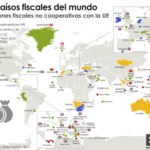Best Offshore Banks offer a world of financial opportunities, but navigating this landscape requires careful consideration. Choosing the right offshore bank hinges on understanding your specific needs, risk tolerance, and long-term financial goals. This guide unravels the complexities of offshore banking, providing insights into selecting the best institution for your circumstances, from understanding regulatory environments to assessing security measures and managing your accounts effectively.
We’ll explore the diverse services available, the potential benefits and drawbacks, and equip you with the knowledge to make informed decisions.
From analyzing crucial criteria like financial stability and regulatory compliance to understanding the nuances of international tax laws, we aim to demystify the process of selecting and utilizing offshore banking services. We’ll examine various jurisdictions, comparing their regulatory frameworks and highlighting the implications for asset protection, tax optimization, and overall financial security. By the end of this guide, you’ll be better positioned to determine which offshore bank aligns best with your individual financial strategy.
Illustrative Examples of Offshore Banking Scenarios: Best Offshore Banks

Offshore banking, while offering potential benefits, involves complexities and risks. Understanding these nuances is crucial for making informed decisions. The following case studies illustrate diverse scenarios, highlighting both positive and negative outcomes, and a neutral scenario to provide a balanced perspective.
Successful International Business Expansion
This case study follows Anya Petrova, a Russian entrepreneur who established a successful tech startup. Facing limitations in accessing capital and navigating complex Russian regulations, Anya chose to open an offshore account in a reputable jurisdiction known for its financial stability and favorable tax laws. This allowed her to attract foreign investment, secure favorable loan terms, and efficiently manage her international transactions.
The offshore account facilitated seamless global operations, contributing significantly to her company’s rapid growth and international expansion.Visual Representation: A flowchart showing Anya’s startup in Russia, arrows pointing to an offshore bank account in a stable jurisdiction (e.g., Switzerland), and then further arrows showing increased investment, loans, and global expansion leading to increased profits. The flowchart clearly shows the positive impact of the offshore account on her business.
Failed Investment and Subsequent Legal Complications, Best Offshore Banks
This case study focuses on Mr. David Lee, a businessman who invested heavily in a high-risk venture through an offshore account in a jurisdiction with weak regulatory oversight. The investment failed, resulting in significant financial losses. Furthermore, the lack of transparency and weak regulatory framework in the chosen jurisdiction made it difficult to pursue legal recourse against the parties involved in the failed venture.
This resulted in significant financial losses and protracted legal battles, highlighting the risks associated with poorly researched offshore banking choices.Visual Representation: A diagram illustrating Mr. Lee’s investment flowing into a poorly regulated offshore jurisdiction (represented as a shadowy, unstable structure). Arrows then show the investment failing, leading to financial losses, and further arrows pointing to complex and unsuccessful legal battles.
The overall visual emphasizes the negative consequences of choosing an unreliable offshore banking location.
Strategic Asset Protection and Estate Planning
This case study depicts Maria Sanchez, a successful businesswoman from Spain who established an offshore trust in a jurisdiction with robust asset protection laws. This decision was primarily driven by her desire to safeguard her assets from potential legal challenges and to ensure a smooth transfer of wealth to her heirs. The offshore trust provided a legally sound structure for asset protection and estate planning, allowing her to manage her assets efficiently and minimize potential tax liabilities.
While the initial setup involved some cost, the long-term benefits of asset protection and streamlined estate planning outweighed the initial investment.Visual Representation: A diagram showing Maria’s assets protected within a secure, well-defined offshore trust (represented as a strong, well-built structure). Arrows indicate the smooth transfer of assets to her heirs after her passing. The diagram emphasizes the secure and organized nature of the offshore trust and its positive impact on estate planning.
Ultimately, the pursuit of the “best” offshore bank is a deeply personal journey. While this guide offers valuable insights and comparative analysis, the optimal choice depends entirely on your unique financial profile and objectives. Remember to conduct thorough due diligence, carefully assess the risks, and seek professional advice tailored to your specific circumstances. By understanding the factors discussed—from regulatory environments and service offerings to security protocols and account management—you can confidently navigate the world of offshore banking and make informed decisions that safeguard your financial future.

